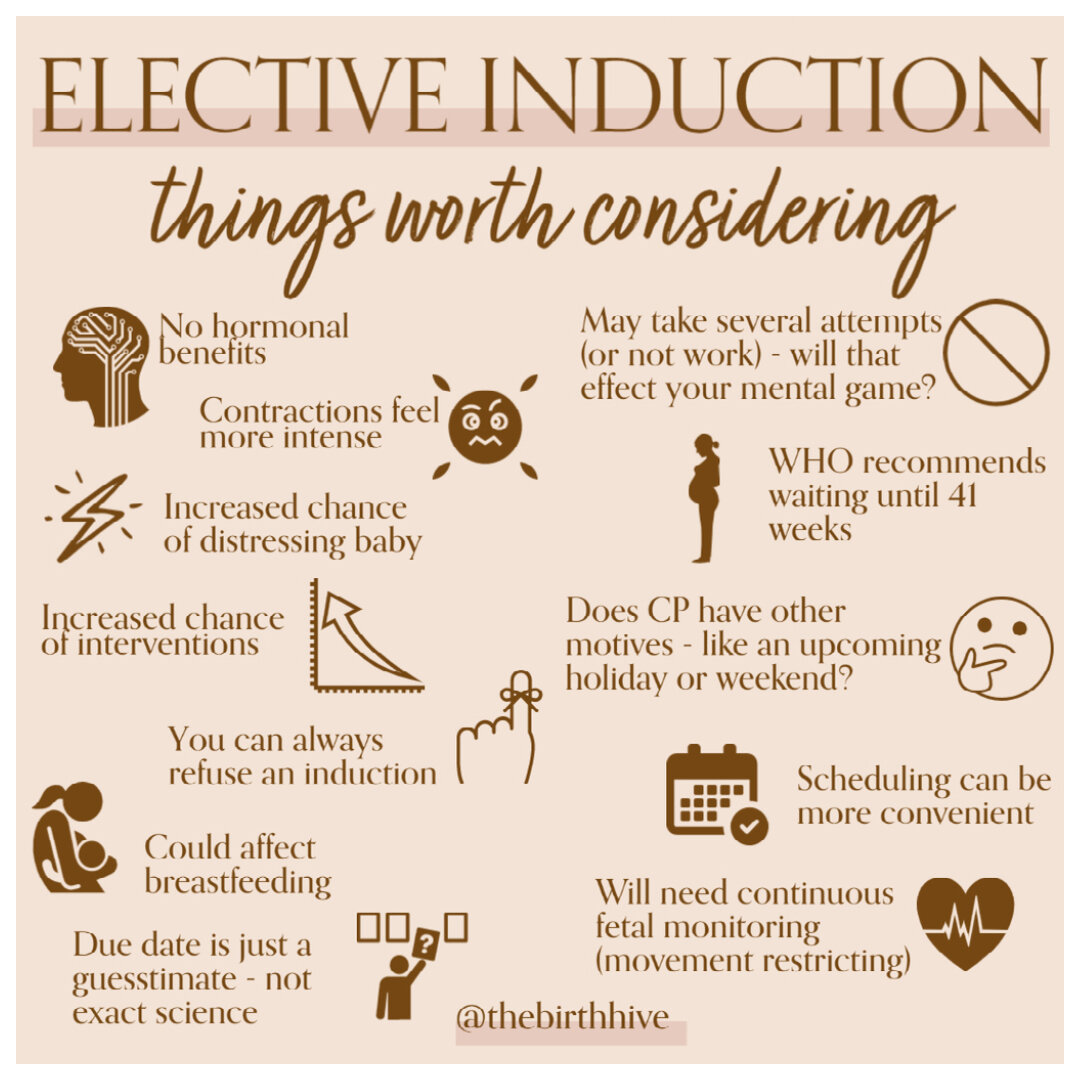From the desk of The Birth Hive
Newest Posts…
Elective Induction: Things Worth Considering
Once we hit the end of our pregnancies, the thought of being able to be done is an attractive one. We’re swollen. Heavy. Tired. Ready to turn the page and transition into the next phase of our life - with the company of the sweet little baby we’ve been patiently waiting for for the last X number of months (maybe even years!). So, yeah, if you’re thinking about elective induction to gently nudge that process along, you aren’t alone. 1 in 5 births in Canada receive a little “help” via medical induction. My goal, here, isn’t to sway you one way or another. It’s to hopefully provide a foundation of knowledge regarding elective inductions so that you don’t have to look back at your experience and say “I wish I had known.” Keep in mind, there is a lot more information to be learned about induction besides what you read here. The pieces here are just drops in a large bucket. Don’t start and stop here, birth boss. Keep reading. Keep learning. Keep asking questions. With that aside, here are some things worth considering about elective induction.
It’s Not a Quick Fix
Just because you’re being induced, doesn’t mean your labour will be fast. Your cervix has the ultimate say in how the induction process will start for you. Your cervix needs to be "favourable" (ie. has started to thin + efface) before you can receive Pitocin, a synthetic form of the hormone oxytocin, that brings on contractions.
If it hasn't already, prompting your cervix to start thinning + effacing via cervical ripening agent will be the first order of biz. Depending on your cervix, this cervical ripening stage can take a few doses - which can translate over the course of two or three days. We all know how important a strong mental state is for birth. Would two or three "attempts" to induce work against your mental game? Will it psyche you out? Will it frustrate you? Will it introduce self-doubt in your body’s capabilities? Will the process exhaust you before you've even started labour? All things worth considering.
No Hormonal Benefits
It’s important to understand that, despite the terms sometimes being used interchangeably, there’s a big difference Pitocin and oxytocin. In the most basic context, oxytocin is a naturally-occurring hormone (“the love hormone”) that is responsible for bringing on and maintaining the uterine contractions we experience during birth. Pitocin is a synthetic form of oxytocin. That means it’s function is to stimulate uterine contractions but there’s a very important piece of the chain missing: birthers don't reap any of the hormonal benefits we experience from the oxytocin we experience with physiologic birth as Pitocin doesn’t cross the blood-brain barrier.
Without the hormonal component that helps us cope with contractions (as found with naturally-occurring oxytocin), Pitocin contractions can feel more intense. We may have a harder time managing. This likely explains why birthers undergoing induction are more likely to receive an epidural (although, by no means, is it impossible to birth without an epidural via induction).
Breastfeeding
There’s also another important facet that might be affected by the lack of oxytocin we experience when going the induction route: breastfeeding. Oxytocin plays a major role in breastfeeding and, without it, birthers who have been induced are more likely to experience initial breastfeeding challenges and should be prepared to seek the advice and support of a qualified lactation consultant.
Continuous Fetal Monitoring
The reality is, as soon as that Pitocin starts dripping through your IV, your birth becomes much more medical and managed, in order to monitor the well-being of you and your baby. Continuous Fetal Monitoring is one of the measures that goes hand-in-hand with medical induction. Depending on your care facility, you’ll have two disks strapped to your upper and lower abdomen so that your care team can monitor your baby’s heartbeat as well as the contractions. If movement during labour is important to you, this will be a noticeable shift in your care as you will be, more or less, relegated to your hospital bed in order to prevent the monitoring disks from shifting.
Increased Chance of Baby Distress
There’s an increased chance of baby going into distress, or not managing contractions well, with an induction. Why, we can’t say for sure but it’s suspected that it’s a response to the fact that contractions brought on with Pitocin can be stronger, happen more frequently, and potentially last longer than natural contractions. Obviously, this is a chain reaction because, once baby is showing signs of distress, care providers start looking to alternative measures - which leads me to my next point.
Increased Chance of Further Interventions
Commonly referred to as the “cascade of interventions,” meaning the introduction of one intervention (in this case, induction) is the just the starting point for more to follow as a response to the challenges caused by the initial intervention. In the case of induction, the interventions you’re more likely to experience are: epidural, medically-assisted delivery (forceps or vacuum) and c-section.
Ulterior Motives
If you care provider makes an offer, or suggestion, of inducing you not due to medical reasons, it’s time to put on your thinking cap and think critically. Is there a weekend coming up? Could your care provider not wanting to be on call for an upcoming holiday be the real reason behind their offer? This is a really good time to sit back, do some research and decide if an induction is truly in your best interest… or someone else’s.
The Due Date Issue
Your due date is not an exact science. It’s an educated guess, at best. What do I mean by this? I mean, your care provider might be making a decision based purely on your timeline… a timeline that is, more likely than not, inaccurate and not a true reflection of how far along you are. If that timeline is off, your baby may be born too early and miss out on the benefits of remaining in utero.
Convenience Factor
With that said - what if the convenience pendulum swings in your favour? Maybe an induction is an attractive option for you because you have a partner who works out of town and may potentially miss the birth of your baby unless it’s scheduled. Maybe you have an older child and the thought of having to leave him/her at a moment’s notice in the middle of the night to go to the hospital is causing you a significant amount of stress. Maybe you live far away from your hospital or birthing centre and being able to control when your labour starts relieves you of the building anxiety about “making it in tiime.” Or, y’know what, maybe you’re just done being pregnant and the thought of being pregnant, even for one more week, is enough to send you into panic mode. All of these scenarios are legitimate and make sense. If you weigh them against the potential “cons” and feel the benefit outweighs them? Then it sounds like you have your decision.
Takeaways
There are true, health reasons that may necessitate a medical induction. This post focuses only on elective inductions - inductions performed for non-medical reasons.
The World Health Organization currently recommends avoiding elective inductions until 41 weeks gestation. This is a bit of discrepancy with current common practice typically seeing the idea of induction introduced by care providers at around the 39 week mark.
Be prepared for this conversation. Expect that your care provider will broach induction with you, at some point. Don’t feel like you need to make a decision immediately when offered. Tell your care provider you will think about it - leave their office and return to your space before discussing it with your partner (if applicable) any further. Let this conversation unfold without curious ears, in the safety net of being on your own territory without any immediate pressures to make a decision. Do your research. Learn about the induction process and what it looks like. Familiarize yourself with the pros and cons. Be objective. You can always, always refuse an offer of elective induction











